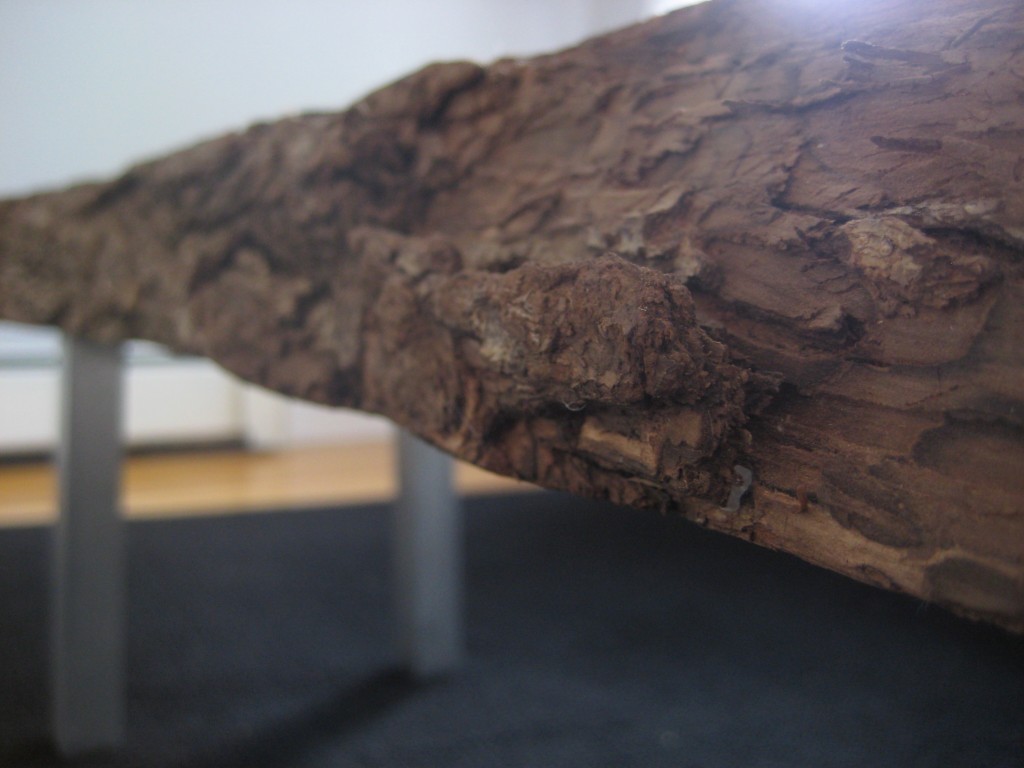When I first started seeing slab tables pop up in design blogs and home magazines in the past few years, my mind went immediately to the coffee table that has graced my parents’ living room for the entirety of my life – a veritable half of a tree, finished to a deep reddish glow. My father owns a carpentry business, and I knew from my years working by his side that there were several more slabs like that table, air-drying for decades, in the family warehouse.
And so, of course, when we moved into our Fort Hill space last fall, I set about making plans for a modernized slab of my own.
Though we’ve shared pictures of it previously, I felt our coffee table was long overdue for a feature all to itself. It’s a favorite, and with more and more pieces in this style popping up, it’s high time that someone point out that you can, in fact, make such a marvelous conversation starter yourself. (Alternatively, we would be more than happy to make one for you.)
It’s important to note that wood like this is practically useless as lumber – our piece has cracks, knots and the fork of the tree – so if you have the right source (ie. a carpenter father or an in at the lumber yard), a slab with character not as difficult to come by as you might otherwise imagine.
The character, along with the size, are exactly what made this particular slab the piece that my parents chose for our table, and brought to Boston during a visit last October. It leaned, raw and sans legs, against our living room wall until I got around to finishing it; it was a conversation piece from the start.

After much research, we opted to finish the table with a blend of tung oil and varnish that is available, pre-mixed, at many hardware stores. We wanted to provide some protection from moisture (we do love cocktail parties, after all), but wanted to avoid the high-gloss, thick look of polyurethane. The tung oil provides some moisture resistance, and brings out the lovely color of the wood, while maintaining a very smooth, natural feel on the surface. The varnish qualifies the finished wood as not foodsafe, but it is a table after all; it aids the drying process (shortening the finishing time to a matter of days, rather than weeks) and helps the wood soak oil further beneath the surface.
After several days spent with the slab laid out in the midst of our dining room floor, varnish applications every 12-24 hours for a few days and much sanding, our table was ready for some legs. Though I did find that table legs can be purchased at mostly reasonable prices online, a very special uncle who is a metal worker by trade welded legs to spec for our particular piece. We opted for a simple, square aluminum leg to counter the rustic look and feel of the wood. Once the legs were in our hands, all that remained was to measure, drill and bolt them to the table.
Et, voilà! Our table is complete.

Works well for Scrabble, too.
We’re pondering putting a few more of these into production, and are considering what other types of salvaged wood might make fantastic tables. What do you think? Have you seen these tables cropping up, and would you try one in your space?





…and I think it still looks absolutely fantastic! The really great thing about these tables is that they are indestructible, as ours looks today just like it did when it was built more than thirty years ago. It’s a lovely addition to your living room.
Pingback: Tweets that mention Union Jack Creative – Working with Walnut -- Topsy.com
Pingback: Union Jack Creative – Friday Fancies
Pingback: Union Jack Creative – Insane in the Membrane
Pingback: Union Jack Creative – House and Home
Literally something I’ve always wanted in our space…I’d take a tree, even.